13 Things to do in Hanoi, Vietnam
- Next Stage Travel
- Sep 27, 2022
- 12 min read
Updated: Aug 28, 2023
13 things to do in Hanoi, Vietnam
1. The Night Market in Old Town
This night market, aka the Weekend Market, is located along Pho Hang Dao/Pho Hang Ngang/Hang Duong/P. Dong Xuan (these are all the same street; the name changes several times) on Friday-Sunday from 6 – 10 pm. It runs about a kilometer in length. You can find clothes, shoes, souvenirs, sunglasses, etc. Many food vendors set up on street corners but we wouldn’t call this a food-oriented market.
A better place to go for produce and food is the street one block to the east of Pho Hang Dao, and running parallel to the Weekend Market – the north end starts behind the Dong Xuan market along Nguyen Thien Thuat street and the south end is around P. Hang Giay. Fortunately enough, this is also where Ta Hien Beer Street is located. This is mostly a day market (and appears to operate every day) and starts to peter out about 7 PM. You can find fresh/live seafood, produce, herbs, dried meat, teas and many, many street-side restaurants.
Like Lenin and Mao, Ho Chi Minh is embalmed and available for public viewing. Viewing Ho Chi Minh (or Uncle Ho, as many call him) was a fun experience for us. Finding the correct entrance was the hardest part. When we used Google maps, it sent us to what appeared to be an employee entrance. Guards there kindly directed us to the main entrance. Seeing Uncle Ho was otherwise well-organized.
Note that the mausoleum is only open in the mornings (summer: 7:30-10:30 AM and winter: 8-11 AM; Tues-Thurs, Sat and Sun). You first go through security. If you need to check a backpack, they give you a canvas bag at security and point where to go. (It’s free to check your bags). After that, you get in a line that, although long, keeps moving. We probably spent no more than 15 minutes as we walked about half a kilometer to the Mausoleum. No cell phone or camera photography are allowed near the Mausoleum. Keep your phone/camera in your pocket and you are ok. If your camera is too big, there is a camera checkpoint about half way through the line to get into the museum, and you will pass the checkpoint again on your way out of the mausoleum. You view Ho Chi Minh while walking around his corpse. He looks like he’s just taking an extended nap. Note that there is no charge to enter the Mausoleum. There are a few stairs required; it was not clear if there are options for disabled visitors.

After the Mausoleum, you can look at several cars he used in presidential functions, two houses he lived in and some meeting rooms. The stilt house, one of the houses he lived in, is fun to walk around. It feels a little like a Frank Lloyd Wright house with a lot of wood and beautiful furniture. There are also some souvenir shops where you can buy various items with Uncle Ho’s portrait. You pay 25,000 dong per person (about $1) for this area. Last but not least, there is the Ho Chi Minh museum detailing his life and legacy, which costs an additional 40,000 dong per person. This museum is definitely geared towards Vietnamese visitors; we did learn more about Ho Chi Minh but it’s not well-curated in English.

Stilt house

Study in the stilt house
3. Quan Thanh Temple (Đền Quán Thánh)
This temple is located just north of the Ho Chi Minh mausoleum complex and just south of Ho Tay (West Lake). With a 10,000 dong per person entrance fee, you can wander around the small, quiet complex filled with trees and statues.

Entrance

Entrance as seen from inside the temple

Elephant statue
4. Đền Ngọc Sơn (Jade Mountain Temple; sometimes called the Turtle Temple)
This temple is located on an island in Hoan Kiem lake. The temple and grounds are relatively small but lovely. We went at about 8 pm (the temple is open until 10 pm Friday-Sunday) and it’s a great way to see Old Town in all its noise and glory. Highlights include the preserved carcasses of two enormous freshwater snapper turtles, a large, old bonsai at the south end of the island and interesting worship areas. According to the sign in the turtle room, the turtles are Rafetus swinhoei (aka Ho Guom turtle, the Yangtze giant softshell turtle or the Hoan Kiem turtle) and only 6 living specimens are known. Of the two preserved turtles, one died in 1967 and the other in 2016. Each turtle is about 2 meters long. The bridge/entrance (called the Welcoming Morning Sunlight Bridge) is on the east side of the lake. Admission is 30,000 dong per person.

Welcoming Morning Sunlight bridge (lit up at night)

Big turtle

Grounds of Ngoc Son temple
This fascinating museum is located just south of Hoan Kiem lake and the Old Town. While the museum focuses on achievements and contributions of women in Vietnam, it’s also a well-done ethnography museum with detailed information about various lifecycle events among ethnic groups throughout time and location in Vietnam. We learned a lot about marriage, various family rituals and work, and religion. This museum was the first place we learned about the Mother Goddess and her four incarnations, which is a significant part of the religion of many ethnic groups in Vietnam.

Wedding outfits for bride and groom

Wedding outfits for bride, groom and bridesmaid

Entrance to the Women’s Museum
Many people (Americans in particular) when they think of Vietnam and military, think of the recent Vietnam war. Vietnam, however, has been at the center of various wars and rebellions for over two thousand years, and this museum provides that context leading up to French occupation from the mid-1800s – 1950s, and the Vietnam War. We always find it interesting how different countries view American involvement. Not surprisingly, in this museum, America is not the hero in the story of Vietnam independence and reunification (of the north and south). PS, in Vietnam, this war is called the American War. On the grounds of museum are many tanks, airplanes and other vehicles that were used or captured during the Vietnam War. Also on the grounds is the Hanoi Flagtower, which you can climb for a nice view. Originally, the tower was part of the Imperial Citadel, having been built as an observation post in 1812.
Cost of admission is 40,000 dong/person (about $1.75 in 2022).
This is the site of Vietnam’s oldest university founded in 1070 and in existence until 1779. Now people come to pray for good outcomes in education and roam the peaceful grounds. There are three main courtyards with gardens and ponds. In the second courtyard are over 150 steles – stone tablets inscribed with the names of all the people who passed the regional and national mandarin examinations between 1400-1779 (Mandarins were people (men) who ran an area on behalf of the king). Each tablet is held by a stone giant soft-shelled turtle. The turtles are interesting because each one is different. In the third courtyard is the temple of Confucius. There is also a small exhibition about the mandarin training and examinations, as well as a calligrapher who can make a custom blessing/prayer for your desired academic, financial or love success (200,000 dong).
The Temple of Literature is located near the Imperial Citadel, Ho Chi Minh’s mausoleum and the Vietnam Military History museum, so one could visit all or most of these in a day. Additionally, it’s near the KOTO restaurant and several interesting clothing shops. Entry fee is 30,000 dong per person (about $1.30).
The museum actually consists of two buildings. One building covers from prehistory to 1945 and the second building covers 1945 to present. The building covering prehistory-1945 is pretty well curated with some interesting temporary exhibits as well (in our case an exhibit on the relations between Korea and Vietnam). Humans first settled in what is now Vietnam about 1 million years ago. Various cultures and kingdoms that arose 2,000-4,000 years ago are still being discovered and excavated. Starting about 2,000 years ago, the Han dynasty (China) conquered Vietnam. Although there were various rebellions thereafter, Vietnam was only able to become independent in the late 900s. Thereafter, a large number of dynasties and emperors ruled. Interestingly, the vast majority of emperors ruled no more than 2-3 years; I only saw one emperor that ruled 20 years. Apparently, assassinations and plotting were common. Vietnam is also one of the few countries to repel the Mongols (three different times!). There is also a really interesting exhibit on early Champa culture with some very well preserved sandstone sculptures. The Champa were a group of independent kingdoms that ruled central and southern Vietnam for a long period from 2nd century AD until the mid-1800s.
The second building discusses the American war and rebuilding. Unfortunately, there is little to no curation, so you can get the gist of things by reading captions on exhibits and photos but not much more context.
Go to the building at 1 Trang Tien Street first. We made the mistake of going to the other building first (at 216 Tran Quang Khai Street) and were so disappointed with the curation, we almost didn’t go 1 Trang Tien Street. Entry cost is 40,000 dong/person.
We loved this museum and recommend it for folks of all ages. If you are traveling with young kids, this is a must do because there are wide-open spaces, things outside to interact with, and accessible exhibits inside. We visited on a Sunday and it was packed with local families. But it’s also great if you don’t have kids. We learned a lot from this museum about local cultures. If you do not have time to visit a Hmong or Tay village in the North while you are in Vietnam, this is the next best thing, and if you do have time, the museum will expand on what you learn there. The museum took us more than a half day.
TIP: bring your own food to have a picnic here. There is a “restaurant”–that only served drinks, ice cream, and Western fast food. At the back of the complex there is a second restaurant, about half way through the model home exhibits. They had fried rice with pork, plus Western fast food.
This is a well-curated museum about the 54 ethnic minorities in Vietnam. It also includes a section on the Viet people who make up 85% of the country. Various maps and descriptions explain how various ethnic minorities have arrived in Vietnam over the last 2,000-3,000 years (some groups just in the last 100 years) and the various customs and crafts each group pursues. In particular, exhibits emphasize the interconnectedness of various groups in terms of trade, commerce and in some cases, religious or social customs. After exploring the main building, be sure to visit the taller building just to the right of the main museum (and within the grounds of the Ethnology museum, so no new ticket needed) containing various collections of Southeast Asian art. Additionally, the grounds of the museum contain about 16 rebuilt houses from various groups. From stilted houses to long houses to thick-walled clay houses; it’s interesting to explore how each home is set up and operates. Some homes contain multiple generations of a family; some are much smaller. Most of the houses are set up for you to go inside and explore.
Finally, it turned out the museum offers water puppet shows on the weekends (10:00-10:30 and 11:00-11:30 AM, 2:00-2:30 and 3:30-4:00 PM). At 50,000 dong/person, it’s a reasonable price. Plus, the musicians are live performers.
The museum itself costs 40,000 dong per person. It’s about 5 km west of the Old Town and there didn’t seem to be much else nearby. However, the museum itself can take up half a day or more, and it’s really worth seeing. Our hotel set up a car to go there and then we used Grab (the Southeast Asia alternative to Uber) to get a car back.
10. Cooking Lesson
After several weeks in Vietnam, we decided to try a cooking class. Many blogs and websites recommend taking a cooking class and/or food tour early in your trip but, for us, we found the opposite to be true. We enjoyed randomly discovering all kinds of food and learning about the ingredients on our own, first. By the time we took the cooking class, we knew what we wanted to learn to make and were able to ask deeper questions about the dishes as well as food culture. We chose Apron Up cooking class because a) they had numerous, good reviews online, b) they offered private classes for the three of us (our oldest son joined us for part of the trip in Vietnam) and c) they allowed us to choose what we wanted to make (from a long list). A bonus was that we asked for and got to make a dish that was not on their list (bun bo nam bo). Finally, they gave us a recipe book with the dishes we made plus a number of other popular dishes (e.g., banh xeo).
Over an almost 4 hour class, we visited the outdoor parts of Dong Xuan market (where the fresh produce, herbs and food are located), and cooked (and ate!) five dishes together. Our instructor, Siri, was fun and knowledgeable. At the market, for instance, we already knew about the ingredients we were buying for the dishes, so Siri explained how the market works in terms of farmers/producers, middle-men and vendors, and also talked about other aspects of family culture, food and dining. We made bun bo nam bo, banana flower salad, papaya salad, pho cuon and egg coffee; all were fun to make and delicious.
11. Imperial Citadel
The Imperial Citadel of Thăng Long was constructed in 1011, when the king of that time (Lý Thái Tổ) moved the capital from Hoa Lu (in Ninh Binh province) to Hanoi. It originally contained a small city within its walls. Most of the buildings were destroyed in the late 19th century by the French, leaving today just the southern gate (Doan Mon), the Flag Tower (now on the grounds of the Vietnam Military Museum nearby), and the Princess Palace (Hậu Lâu). It’s pleasant to stroll around the grounds for an hour or so, and view the ongoing archeological excavations of several generations of buildings.
12. Hỏa Lò Prison
Most Americans know of Hoa Lu prison (pronounced ‘hwa lo’) as the place where captured American soldiers (mostly aviators) were kept during the Vietnam war. Hoa Lu means ‘hell hole’ or ‘fiery furnace’. It was actually built by the French in the late 1880s to imprison Vietnamese revolutionary fighters (both men and women) under pretty miserable conditions. Most of the prison was demolished in the 1990s but the gatehouse and some buildings remain as a museum and memorial. Various prison cells and common rooms are depicted, some with life size plaster casts showing how Vietnamese prisoners were kept shackled; there were separate sections for men and women, as well as a small section for women who had children while in prison. There are also some rooms showing equipment used in the prison such as the guillotine. There is a section on American soldiers kept at Hoa Lu, describing the humane conditions and showing various pictures of smiling and apparently healthy servicemen at the prison. Again not surprisingly, accounts by American soldiers held there paint a slightly different picture of torture, broken bones and food contaminated with feces. There are also several exhibits honoring Vietnamese revolutionaries from the early to mid-20th century, both those who escaped to continue fighting as well as those who lost their lives in the prison. Tickets cost 30,000 dong per person.
13. Duong Lam Ancient Village (and side trip to Van Phuc silk village)
Duong Lam is a small town located about 45 km northwest of Hanoi. They have done a good job of preserving the town as it was about 100 years ago, so there are a number of older communal houses, private residences and several pagodas that you can see (and, in a few cases, go inside). Duong Lam is also known for various sweets, so one of our quests there was to try all the local candies/sweets. We spent a fun morning wandering through the town. It’s a compact town with flat roads and little traffic – when we arrived, we were offered bicycles to get around (so if you like low-key biking this is a good place for it) but chose to walk. We got two maps at the entry gate (see photos in gallery – they weren’t terribly helpful except to orient us about general direction) and Sarah had built a google route with about 7 stops for houses, sweets and restaurants. We mostly strolled randomly, arriving in the city square where there were several sweet vendors (see pictures below), and then down small streets and alleys, being surprised by what we found, such as a huge well/cistern at the end of one alley. Sweets included che lam (a mochi-like sweet with nuts), peanut brittle, che kho (mung bean pudding) and doi candy (sausage candy – with a center like peanut brittle and wrapped in a ginger-flavored, white candy exterior).
We had mapped what appeared to be a restaurant near the main square but it turned out to be mostly a teahouse/cafe that served tea with sweets. They made fermented bean paste in big ceramic pots and sold it by the liter. Additionally, they also made their own rice wine. A nice old man showed us the plastic liter bottles of it for sale and proudly pointed to his picture on the label (i.e. he made the wine); we sampled it and found it tasted a little like port, so we bought a bottle (for 50,000 dong/US$2.20).
On our way back to Hanoi, we stopped at Van Phuc silk village. If you love silk and shopping, you might like it. But even Sarah, a professional shopper, was unimpressed with both the items and the prices. Basically, it’s a long street with several hundred shops all selling similar silk products. Many sell fabric as well, and perhaps if you wanted a custom outfit, this might be a good place to buy. But, at 600,000-700,000 dong (USD$25-28) per meter of silk (many vendors also sold rayon by the meter at 200,000-300,000 dong/meter), it’s no bargain. The best part was watching a few gigantic electric looms making silk fabric – this was cool to watch the fabric and patterns take shape but probably not worth a side trip just for this.


























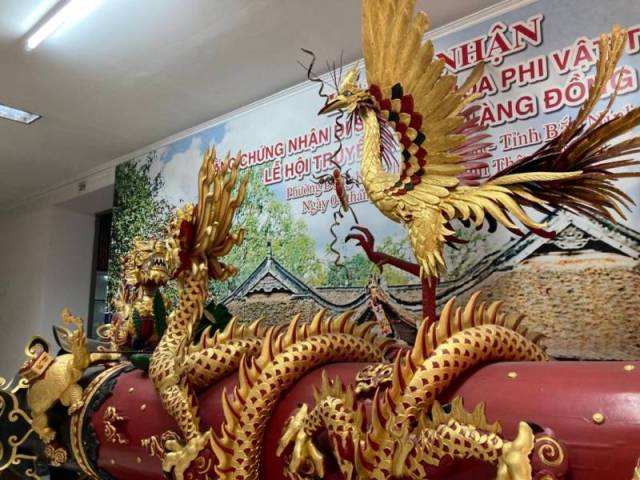



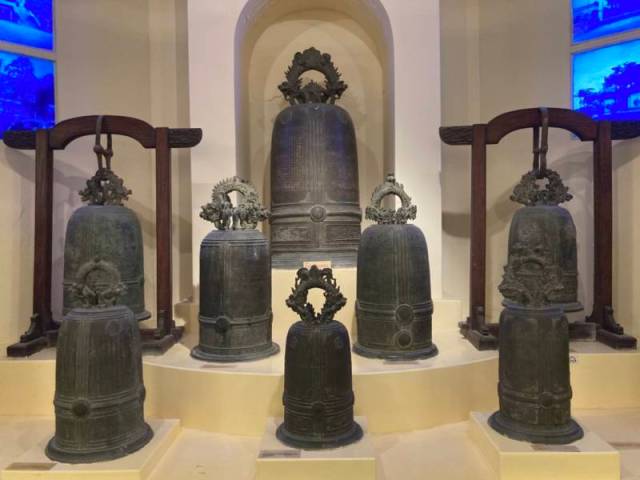




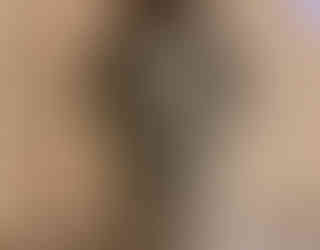














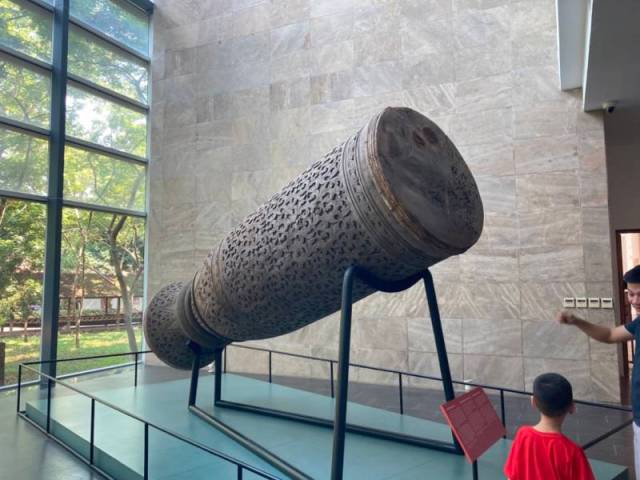





































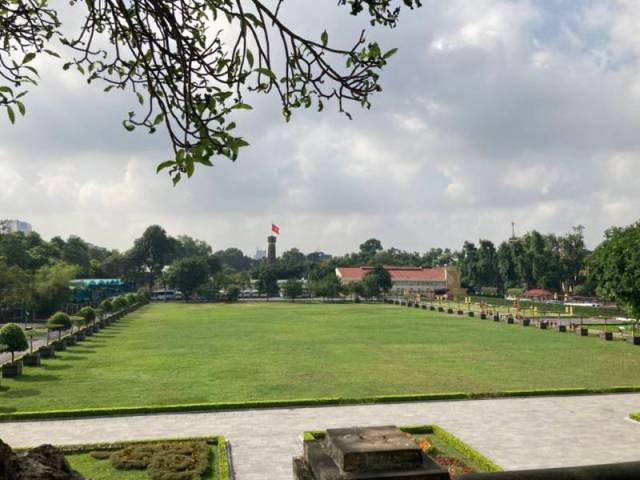






























Comments